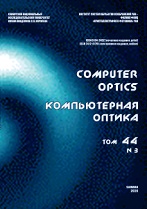|
This article is cited in 11 scientific papers (total in 11 papers)
IMAGE PROCESSING, PATTERN RECOGNITION
A solution method for image distortion correction model based on bilinear interpolation
J. Li, J. Su, X. Zeng
College of Information Science & Engineering, Hunan International Economics University, Changsha 410205, China
Abstract:
In the process of the image generation, because the imaging system itself has differences in terms of nonlinear or cameraman perspective, the generated image will face the geometric distortion. Image distortion in general is also a kind of image degradation, which needs the geometric transform to correct each pixel position of the distorted images, so as to regain the original spatial relationships between pixels and the original grey value relation, and which is also one of important steps of image processing. From the point of view of the digital image processing, the distortion correction is actually a process of image restoration for a degraded image. In image processing, in terms of the image quality improvement and correction technology, namely the image restoration, with the wide expansion of digital image distortion correction processing applied, the processing technology of the image restoration has also become a research hotspot. In view of the image distortion issue, this paper puts forward the image distortion correction algorithm based on two-step and one-dimensional linear gray level interpolation to reduce the computation complexity of the bilinear interpolation method, and divide the distorted image into multiple quadrilaterals, and the area of the quadrilateral is associated with the distortion degree of the image in the given region, and express the region distortion of each quadrilateral with the bilinear model, thus determining parameters of bilinear model according to the position of the quadrilateral vertex in the target image and the distorted image. Experiments show that such algorithm in this paper can meet the requirements of distortion correction of most lenses, which can accurately extract the distorted edge of the image, thus making the corrected image closer to the ideal image.
Keywords:
image distortion, bilinear interpolation, correction model.
Received: 26.01.2018
Accepted: 09.12.2018
Citation:
J. Li, J. Su, X. Zeng, “A solution method for image distortion correction model based on bilinear interpolation”, Computer Optics, 43:1 (2019), 99–104
Linking options:
https://www.mathnet.ru/eng/co609 https://www.mathnet.ru/eng/co/v43/i1/p99
|

| Statistics & downloads: |
| Abstract page: | 132 | | Full-text PDF : | 203 | | References: | 20 |
|




 Contact us:
Contact us: Terms of Use
Terms of Use
 Registration to the website
Registration to the website Logotypes
Logotypes








 Citation in format
Citation in format 
